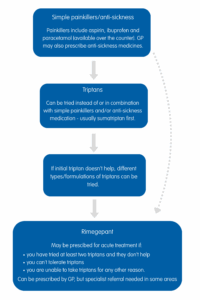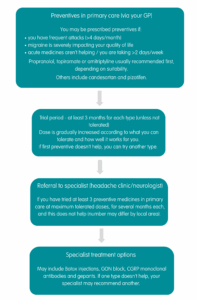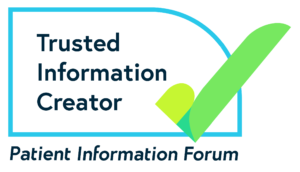Migraine treatment pathway
There are many treatment options available to help manage migraine. Here, we give the recommended treatment pathways for migraine in adults in the UK.
Types of migraine treatment
Everyone’s experience of migraine is very different – and people’s needs when it comes to treatment will be very different too. Unfortunately, there is currently no cure for migraine. But there are many treatment options available to help manage it.
Migraine treatment is split into:
- acute treatment – to reduce or stop symptoms of a migraine attack as it happens
- preventive treatment – aimed at reducing the number or severity of attacks over time.
Migraine treatment often involves what is known as a ‘stepped approach’. This means you start with one treatment and add in or swap to additional treatments if this doesn’t work for you. You may also take different types of treatment at different times, depending on how severe your symptoms are.
Some treatments you may be able to purchase yourself or access through a pharmacy. Others may need to be prescribed by your GP. Some require referral to a headache clinic or specialist in migraine – such as a neurologist. Rules around access to medicines can differ by local area.
Below we give the recommended pathways for acute and preventive migraine treatment for adults in the UK. These are based on clinical guidelines for health professionals.
It’s important to understand that treatment pathways can vary by local area. They can also be different for specific types of migraine, like hemiplegic migraine. Your doctor will tailor treatment to your individual needs. It can help to keep a headache diary to monitor how well your treatments are working – some clinics require this. Talk to your doctor for more information about your own treatment options.
Acute treatment pathway for migraine

We have more information about acute medicines, including triptans and gepants.
Preventive treatment pathway for migraine

It’s important to note you will still usually need to continue taking acute medicine in addition to preventive treatment. Even if a preventive medicine works well for you, it’s unlikely to stop all of your migraine attacks.
You don’t normally need to take preventive medicine long-term. Your doctor may suggest gradually reducing and stopping a preventive after around 6 months, if your migraine is under control.
You can discuss restarting preventive medicine again with your doctor, if you need it.
We have more information on preventive medicines, including:
Other treatment options
Medicines can be effective for many people with migraine. But there are other ways to manage migraine too. There are various self-management strategies you can try alongside medicines that may help you to cope with a migraine attack.
Non-drug treatments for migraine include acupuncture, migraine devices, supplements and behavioural techniques. You can try these alongside or instead of medicines, to see if they help improve your migraine.
It may also help to avoid known triggers for your migraine attack. However, this can be difficult and is unlikely to stop migraine attacks completely.
Some people also find it helps to make adjustments to lifestyle such as finding ways to reduce stress, being more active, or getting into a good sleep routine. Again, these things won’t cure migraine, but they may have a positive impact on your migraine attacks, or help you cope with attacks better.
Getting access to treatments
Your GP will normally be the first person you see about your migraine. You may also see a community pharmacist, specialists in a headache clinic (such as a neurologist or GP who specialises in headache and migraine) and headache nurses about your migraine treatment.
Getting the right treatment for migraine can be difficult. Trying several different medications to find which one that works for you can take a long time. Waiting lists for specialist care can also be lengthy. On top of this, there is often a lack of understanding about the different treatment options available. It’s important to work with the health professionals involved in your care to make sure you get the best treatment for you.
We have more tips to help you navigate the system and advocate for your care and treatment.
Further information
This information is based on the following clinical guidelines for health professionals:
- NICE clinical guideline CG150. Headaches in over 12s: diagnosis and management. nice.org.uk/guidance/cg150
- NICE Clinical Knowledge Summary. Migraine. cks.nice.org.uk/topics/migraine
- British Association of the Study of Headache (BASH). National Headache Management System for Adults. Access the PDF
- SIGN clinical guidelines 155. Pharmacological management of migraine. sign.ac.uk/our-guidelines/pharmacological-management-of-migraine
NICE also have a visual summary of the prophylactic (preventive) treatment of migraine with or without aura, for health professionals. Access the PDF
About our information
 This information has been written by The Migraine Trust Information and Support Services team. It has been reviewed by our panel of expert health professionals and people affected by migraine.
This information has been written by The Migraine Trust Information and Support Services team. It has been reviewed by our panel of expert health professionals and people affected by migraine.
Our information has been awarded the PIF TICK quality mark for trustworthy health information.
If you have feedback on our information, please get in touch at: feedback@migrainetrust.org
References for our information are available on request.
Last reviewed: September 2025 | Next review due: September 2028


